
Concept explainers
(a)
Interpretation:
It is to be indicated whether the given conversions would be energetically favorable or unfavourable. Also, it is to be given if the reaction is likely to occur readily.
Concept introduction:
Nucleophilic acyl substitution describes a class of substitution reactions involving nucleophiles and acyl compounds. An acid derivative has a leaving group, which is substituted by a nucleophile. If the leaving group is more stable than the nucleophile (weaker in terms of basicity), then the reaction is energetically favorable and occurs readily. If the nucleophile is more stable than the leaving group, then the reaction is enegetically unfavorble and does not occur readilty. This can be explained on the basis of the stability ladder below:
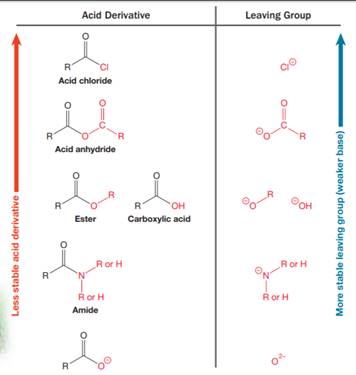
An acyl substitution that converts an acid derivative from a higher rung on the stability ladder to one on a lower rung of the ladder is energetically favorable. An acyl substitution that converts an acid derivative from a lower rung on the stability ladder to one on a higher rung of the ladder is energetically unfavorable.
Answer to Problem 20.5YT
The given conversion would be energetically unfavourable, and the reaction does not occur readily.
Explanation of Solution
The given reaction is

This is an example of a nucleophilic acyl substitution reaction in which an anhydride is getting converted into an acyl chloride. An acid derivative has a leaving group, which is substituted by a nucleophile. If the leaving group is more stable than the nucleophile (weaker in terms of basicity), then the reaction is energetically favorable and occurs readily. If the nucleophile is more stable than the leaving group, then the reaction is enegetically unfavorble and does not occur readilty. This can be explained on the basis of the stability ladder below:
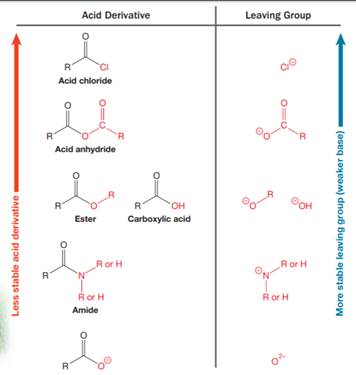
An acyl substitution that converts an acid derivative from a higher rung on the stability ladder to the one on a lower rung of the ladder is energetically favorable. An acyl substitution that converts an acid derivative from a lower rung on the stability ladder to one on a higher rung of the ladder is energetically unfavorable.
Referring to this chart, an acid chloride is from a lower rung while an acyl chloride is from a higher rung on the stability ladder. Thus, this reaction is energetically unfavorable and so does not occur readily.
Conversion of an acid derivative from a lower rung to higher rung on the stability ladder is energetically unfavourable, and the reaction does not occur readily.
(b)
Interpretation:
It is to be indicated whether the given conversions would be energetically favorable or unfavourable. Also, it is to be given if the reaction is likely to occur readily.
Concept introduction:
Nucleophilic acyl substitution describes a class of substitution reactions involving nucleophiles and acyl compounds. An acid derivative has a leaving group, which is substituted by a nucleophile. If the leaving group is more stable than the nucleophile (weaker in terms of basicity), then the reaction is energetically favorable and occurs readily. If the nucleophile is more stable than the leaving group, then the reaction is enegetically unfavorble and does not occur readilty. This can be explained on the basis of the stability ladder below:
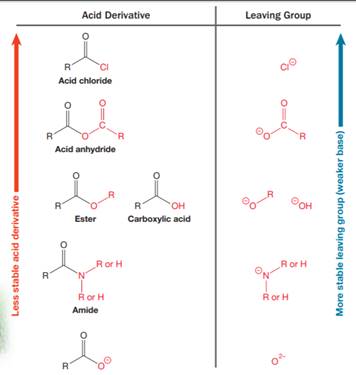
An acyl substitution that converts an acid derivative from a higher rung on the stability ladder to one on a lower rung of the ladder is energetically favorable. An acyl substitution that converts an acid derivative from a lower rung on the stability ladder to one on a higher rung of the ladder is energetically unfavorable.
Answer to Problem 20.5YT
The given conversion would be energetically unfavourable, and it does not occur readily.
Explanation of Solution
The given reaction is

This is an example of a nucleophilic acyl substitution reaction in which an amide is getting converted into an ester. If the leaving group is more stable than the nucleophile (weaker in terms of basicity), then the reaction is energetically favorable and occurs readily. If the nucleophile is more stable than the leaving group, then the reaction is enegetically unfavorble and does not occur readilty. This can be explained on the basis of the stability ladder below:
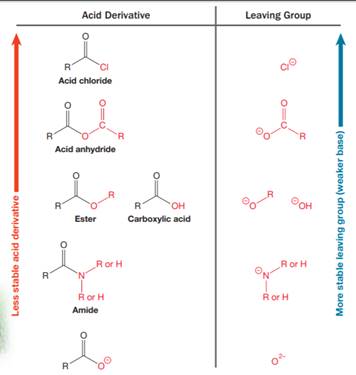
An acyl substitution that converts an acid derivative from a higher rung on the stability ladder to one on a lower rung of the ladder is energetically favorable. An acyl substitution that converts an acid derivative from a lower rung on the stability ladder to one on a higher rung of the ladder is energetically unfavorable.
Referring to this chart, an amide is from a lower rung while an ester is from a higher rung on the stability ladder. Thus, this reaction is energetically unfavorable and so does not occur readily.
Conversion of an acid derivative from a lower rung to higher rung on the stability ladder is energetically unfavourable, and the reaction does not occur readily.
(c)
Interpretation:
It is to be indicated whether the given conversions would be energetically favorable or unfavourable. Also, it is to be given if the reaction is likely to occur readily.
Concept introduction:
Nucleophilic acyl substitution describes a class of substitution reactions involving nucleophiles and acyl compounds. An acid derivative has a leaving group, which is substituted by a nucleophile. If the leaving group is more stable than the nucleophile (weaker in terms of basicity), then the reaction is energetically favorable and occurs readily. If the nucleophile is more stable than the leaving group, then the reaction is enegetically unfavorble and does not occur readilty. This can be explained on the basis of the stability ladder below:
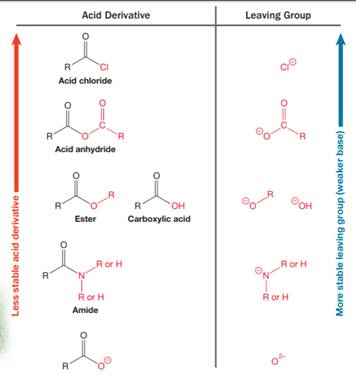
An acyl substitution that converts an acid derivative from a higher rung on the stability ladder to one on a lower rung of the ladder is energetically favorable. An acyl substitution that converts an acid derivative from a lower rung on the stability ladder to one on a higher rung of the ladder is energetically unfavorable.
Answer to Problem 20.5YT
The given conversion would be energetically unfavourable, and it does not occur readily.
Explanation of Solution
The given reaction is

This is an example of nucleophilic acyl substitution reaction in which an acid chloride is getting converted into an ester. If the leaving group is more stable than the nucleophile (weaker in terms of basicity), then the reaction is energetically favorable and occurs readily. If the nucleophile is more stable than the leaving group, then the reaction is enegetically unfavorble and does not occur readilty. This can be explained on the basis of the stability ladder below:
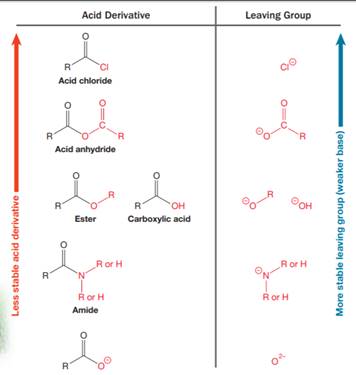
An acyl substitution that converts an acid derivative from a higher rung on the stability ladder to one on a lower rung of the ladder is energetically favorable. An acyl substitution that converts an acid derivative from a lower rung on the stability ladder to one on a higher rung of the ladder is energetically unfavorable.
Referring to this chart, an acid chloride is from a higher rung while an ester is from a lower rung on the stability ladder. Thus, this reaction is energetically favorable and occurs readily.
Conversion of an acid derivative from a higher rung to lower rung on the stability ladder is energetically favourable, and the reaction occurs readily.
(d)
Interpretation:
It is to be indicated whether the given conversions would be energetically favorable or unfavourable. Also, it is to be given if the reaction is likely to occur readily.
Concept introduction:
Nucleophilic acyl substitution describes a class of substitution reactions involving nucleophiles and acyl compounds. An acid derivative has a leaving group, which is substituted by a nucleophile. If the leaving group is more stable than the nucleophile (weaker in terms of basicity), then the reaction is energetically favorable and occurs readily. If the nucleophile is more stable than the leaving group, then the reaction is enegetically unfavorble and does not occur readilty. This can be explained on the basis of the stability ladder below:

An acyl substitution that converts an acid derivative from a higher rung on the stability ladder to one on a lower rung of the ladder is energetically favorable. An acyl substitution that converts an acid derivative from a lower rung on the stability ladder to one on a higher rung of the ladder is energetically unfavorable.
Answer to Problem 20.5YT
The given conversion would be energetically unfavourable, and it does not occur readily.
Explanation of Solution
The given reaction is

This is an example of a nucleophilic acyl substitution reaction in which an acid anhydride is getting converted into dicarboxylic acid. If the leaving group is more stable than the nucleophile (weaker in terms of basicity), then the reaction is energetically favorable and occurs readily. If the nucleophile is more stable than the leaving group, then the reaction is enegetically unfavorble and does not occur readilty. This can be explained on the basis of the stability ladder below:

An acyl substitution that converts an acid derivative from a higher rung on the stability ladder to one on a lower rung of the ladder is energetically favorable. An acyl substitution that converts an acid derivative from a lower rung on the stability ladder to one on a higher rung of the ladder is energetically unfavorable.
Referring to this chart, an acid anhydride is from a higher rung while a
Conversion of an acid derivative from a higher rung to lower rung on the stability ladder is energetically favourable, and the reaction occurs readily.
Want to see more full solutions like this?
Chapter 20 Solutions
Organic Chemistry: Principles And Mechanisms (second Edition)
- Predict the products of this organic reaction: Explanation Check IN NaBH3CN H+ ? Click and drag to start drawing a structure. D 5 C +arrow_forwardPredict the products of this organic reaction: H3O+ + ? • Draw all the reasonable products in the drawing area below. If there are no products, because no reaction will occur, check the box under the drawing area. • Include both major and minor products, if some of the products will be more common than others. • Be sure to use wedge and dash bonds if you need to distinguish between enantiomers. No reaction. Click and drag to start drawing a structure. dmarrow_forwardIarrow_forward
- Draw the anti-Markovnikov product of the hydration of this alkene. this problem. Note for advanced students: draw only one product, and don't worry about showing any stereochemistry. Drawing dash and wedge bonds has been disabled for esc esc ☐ Explanation Check F1 1 2 F2 # 3 F3 + $ 14 × 1. BH THE BH3 2. H O NaOH '2 2' Click and drag to start drawing a structure. F4 Q W E R A S D % 905 LL F5 F6 F7 © 2025 McGraw Hill LLC. All Rights Reserved. Terms of Use | Privacy Center | Accessibility < & 6 7 27 8 T Y U G H I F8 F9 F10 F11 F12 9 0 J K L P + // command option Z X C V B N M H H rol option commandarrow_forwardAG/F-2° V 3. Before proceeding with this problem you may want to glance at p. 466 of your textbook where various oxo-phosphorus derivatives and their oxidation states are summarized. Shown below are Latimer diagrams for phosphorus at pH values at 0 and 14: -0.93 +0.38 -0.50 -0.51 -0.06 H3PO4 →H4P206 →H3PO3 →→H3PO₂ → P → PH3 Acidic solution Basic solution -0.28 -0.50 3--1.12 -1.57 -2.05 -0.89 PO HPO H₂PO₂ →P → PH3 -1.73 a) Under acidic conditions, H3PO4 can be reduced into H3PO3 directly (-0.28V), or via the formation and reduction of H4P206 (-0.93/+0.38V). Calculate the values of AG's for both processes; comment. (3 points) 0.5 PH P 0.0 -0.5 -1.0- -1.5- -2.0 H.PO, -2.3+ -3 -2 -1 1 2 3 2 H,PO, b) Frost diagram for phosphorus under acidic conditions is shown. Identify possible disproportionation and comproportionation processes; write out chemical equations describing them. (2 points) H,PO 4 S Oxidation stale, Narrow_forward4. For the following complexes, draw the structures and give a d-electron count of the metal: a) Tris(acetylacetonato)iron(III) b) Hexabromoplatinate(2-) c) Potassium diamminetetrabromocobaltate(III) (6 points)arrow_forward
- 2. Calculate the overall formation constant for [Fe(CN)6]³, given that the overall formation constant for [Fe(CN)6] 4 is ~1032, and that: Fe3+ (aq) + e = Fe²+ (aq) E° = +0.77 V [Fe(CN)6]³ (aq) + e¯ = [Fe(CN)6] (aq) E° = +0.36 V (4 points)arrow_forward5. Consider the compounds shown below as ligands in coordination chemistry and identify their denticity; comment on their ability to form chelate complexes. (6 points) N N A B N N N IN N Carrow_forward1. Use standard reduction potentials to rationalize quantitatively why: (6 points) (a) Al liberates H2 from dilute HCl, but Ag does not; (b) Cl2 liberates Br2 from aqueous KBr solution, but does not liberate C12 from aqueous KCl solution; c) a method of growing Ag crystals is to immerse a zinc foil in an aqueous solution of AgNO3.arrow_forward
- What would be the best choices for the missing reagents 1 and 3 in this synthesis? 1 1. PPh3 2. n-BuLi 3 2 • Draw the missing reagents in the drawing area below. You can draw them in any arrangement you like. • Do not draw the missing reagent 2. If you draw 1 correctly, we'll know what it is. • Note: if one of your reagents needs to contain a halogen, use bromine. Click and drag to start drawing a structure. Xarrow_forwardWhat is the missing reactant R in this organic reaction? N N H3O+ +R + • Draw the structure of R in the drawing area below. • Be sure to use wedge and dash bonds if it's necessary to draw one particular enantiomer. Click and drag to start drawing a structure. fmarrow_forwardThe product on the right-hand side of this reaction can be prepared from two organic reactants, under the conditions shown above and below the arrow. Draw 1 and 2 below, in any arrangement you like. 1+2 NaBH3CN H+ N Click and drag to start drawing a structure. 5arrow_forward
 Organic Chemistry: A Guided InquiryChemistryISBN:9780618974122Author:Andrei StraumanisPublisher:Cengage Learning
Organic Chemistry: A Guided InquiryChemistryISBN:9780618974122Author:Andrei StraumanisPublisher:Cengage Learning
